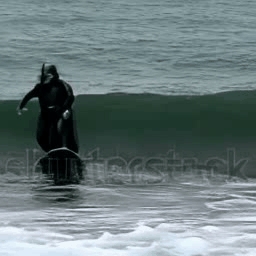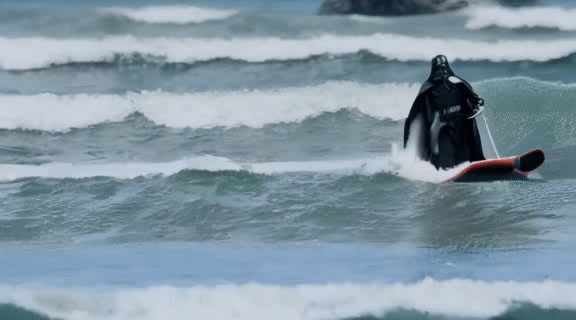Text-to-video
Text-to-video
VideoFusion: Decomposed Diffusion Models for High-Quality Video Generation is by Zhengxiong Luo, Dayou Chen, Yingya Zhang, Yan Huang, Liang Wang, Yujun Shen, Deli Zhao, Jingren Zhou, Tieniu Tan.
The abstract from the paper is:
A diffusion probabilistic model (DPM), which constructs a forward diffusion process by gradually adding noise to data points and learns the reverse denoising process to generate new samples, has been shown to handle complex data distribution. Despite its recent success in image synthesis, applying DPMs to video generation is still challenging due to high-dimensional data spaces. Previous methods usually adopt a standard diffusion process, where frames in the same video clip are destroyed with independent noises, ignoring the content redundancy and temporal correlation. This work presents a decomposed diffusion process via resolving the per-frame noise into a base noise that is shared among all frames and a residual noise that varies along the time axis. The denoising pipeline employs two jointly-learned networks to match the noise decomposition accordingly. Experiments on various datasets confirm that our approach, termed as VideoFusion, surpasses both GAN-based and diffusion-based alternatives in high-quality video generation. We further show that our decomposed formulation can benefit from pre-trained image diffusion models and well-support text-conditioned video creation.
You can find additional information about Text-to-Video on the project page, original codebase, and try it out in a demo. Official checkpoints can be found at damo-vilab and cerspense.
Usage example
text-to-video-ms-1.7b
text-to-video-ms-1.7bLet’s start by generating a short video with the default length of 16 frames (2s at 8 fps):
Copied
import torch
from diffusers import DiffusionPipeline
from diffusers.utils import export_to_video
pipe = DiffusionPipeline.from_pretrained("damo-vilab/text-to-video-ms-1.7b", torch_dtype=torch.float16, variant="fp16")
pipe = pipe.to("cuda")
prompt = "Spiderman is surfing"
video_frames = pipe(prompt).frames
video_path = export_to_video(video_frames)
video_pathDiffusers supports different optimization techniques to improve the latency and memory footprint of a pipeline. Since videos are often more memory-heavy than images, we can enable CPU offloading and VAE slicing to keep the memory footprint at bay.
Let’s generate a video of 8 seconds (64 frames) on the same GPU using CPU offloading and VAE slicing:
Copied
It just takes 7 GBs of GPU memory to generate the 64 video frames using PyTorch 2.0, “fp16” precision and the techniques mentioned above.
We can also use a different scheduler easily, using the same method we’d use for Stable Diffusion:
Copied
Here are some sample outputs:
An astronaut riding a horse.

Darth vader surfing in waves.

cerspense/zeroscope_v2_576w & cerspense/zeroscope_v2_XL
cerspense/zeroscope_v2_576w & cerspense/zeroscope_v2_XLZeroscope are watermark-free model and have been trained on specific sizes such as 576x320 and 1024x576. One should first generate a video using the lower resolution checkpoint cerspense/zeroscope_v2_576w with TextToVideoSDPipeline, which can then be upscaled using VideoToVideoSDPipeline and cerspense/zeroscope_v2_XL.
Copied
Now the video can be upscaled:
Copied
Here are some sample outputs:
Darth vader surfing in waves.

TextToVideoSDPipeline
class diffusers.TextToVideoSDPipeline
( vae: AutoencoderKLtext_encoder: CLIPTextModeltokenizer: CLIPTokenizerunet: UNet3DConditionModelscheduler: KarrasDiffusionSchedulers )
Parameters
vae (AutoencoderKL) — Variational Auto-Encoder (VAE) Model to encode and decode images to and from latent representations.
text_encoder (
CLIPTextModel) — Frozen text-encoder (clip-vit-large-patch14).tokenizer (
CLIPTokenizer) — ACLIPTokenizerto tokenize text.unet (UNet3DConditionModel) — A UNet3DConditionModel to denoise the encoded video latents.
scheduler (SchedulerMixin) — A scheduler to be used in combination with
unetto denoise the encoded image latents. Can be one of DDIMScheduler, LMSDiscreteScheduler, or PNDMScheduler.
Pipeline for text-to-video generation.
This model inherits from DiffusionPipeline. Check the superclass documentation for the generic methods implemented for all pipelines (downloading, saving, running on a particular device, etc.).
__call__
( prompt: typing.Union[str, typing.List[str]] = Noneheight: typing.Optional[int] = Nonewidth: typing.Optional[int] = Nonenum_frames: int = 16num_inference_steps: int = 50guidance_scale: float = 9.0negative_prompt: typing.Union[str, typing.List[str], NoneType] = Noneeta: float = 0.0generator: typing.Union[torch._C.Generator, typing.List[torch._C.Generator], NoneType] = Nonelatents: typing.Optional[torch.FloatTensor] = Noneprompt_embeds: typing.Optional[torch.FloatTensor] = Nonenegative_prompt_embeds: typing.Optional[torch.FloatTensor] = Noneoutput_type: typing.Optional[str] = 'np'return_dict: bool = Truecallback: typing.Union[typing.Callable[[int, int, torch.FloatTensor], NoneType], NoneType] = Nonecallback_steps: int = 1cross_attention_kwargs: typing.Union[typing.Dict[str, typing.Any], NoneType] = None ) → TextToVideoSDPipelineOutput or tuple
Parameters
prompt (
strorList[str], optional) — The prompt or prompts to guide image generation. If not defined, you need to passprompt_embeds.height (
int, optional, defaults toself.unet.config.sample_size * self.vae_scale_factor) — The height in pixels of the generated video.width (
int, optional, defaults toself.unet.config.sample_size * self.vae_scale_factor) — The width in pixels of the generated video.num_frames (
int, optional, defaults to 16) — The number of video frames that are generated. Defaults to 16 frames which at 8 frames per seconds amounts to 2 seconds of video.num_inference_steps (
int, optional, defaults to 50) — The number of denoising steps. More denoising steps usually lead to a higher quality videos at the expense of slower inference.guidance_scale (
float, optional, defaults to 7.5) — A higher guidance scale value encourages the model to generate images closely linked to the textpromptat the expense of lower image quality. Guidance scale is enabled whenguidance_scale > 1.negative_prompt (
strorList[str], optional) — The prompt or prompts to guide what to not include in image generation. If not defined, you need to passnegative_prompt_embedsinstead. Ignored when not using guidance (guidance_scale < 1).num_images_per_prompt (
int, optional, defaults to 1) — The number of images to generate per prompt.eta (
float, optional, defaults to 0.0) — Corresponds to parameter eta (η) from the DDIM paper. Only applies to the DDIMScheduler, and is ignored in other schedulers.generator (
torch.GeneratororList[torch.Generator], optional) — Atorch.Generatorto make generation deterministic.latents (
torch.FloatTensor, optional) — Pre-generated noisy latents sampled from a Gaussian distribution, to be used as inputs for video generation. Can be used to tweak the same generation with different prompts. If not provided, a latents tensor is generated by sampling using the supplied randomgenerator. Latents should be of shape(batch_size, num_channel, num_frames, height, width).prompt_embeds (
torch.FloatTensor, optional) — Pre-generated text embeddings. Can be used to easily tweak text inputs (prompt weighting). If not provided, text embeddings are generated from thepromptinput argument.negative_prompt_embeds (
torch.FloatTensor, optional) — Pre-generated negative text embeddings. Can be used to easily tweak text inputs (prompt weighting). If not provided,negative_prompt_embedsare generated from thenegative_promptinput argument.output_type (
str, optional, defaults to"np") — The output format of the generated video. Choose betweentorch.FloatTensorornp.array.return_dict (
bool, optional, defaults toTrue) — Whether or not to return a TextToVideoSDPipelineOutput instead of a plain tuple.callback (
Callable, optional) — A function that calls everycallback_stepssteps during inference. The function is called with the following arguments:callback(step: int, timestep: int, latents: torch.FloatTensor).callback_steps (
int, optional, defaults to 1) — The frequency at which thecallbackfunction is called. If not specified, the callback is called at every step.cross_attention_kwargs (
dict, optional) — A kwargs dictionary that if specified is passed along to theAttentionProcessoras defined inself.processor.
Returns
TextToVideoSDPipelineOutput or tuple
If return_dict is True, TextToVideoSDPipelineOutput is returned, otherwise a tuple is returned where the first element is a list with the generated frames.
The call function to the pipeline for generation.
Examples:
Copied
disable_vae_slicing
( )
Disable sliced VAE decoding. If enable_vae_slicing was previously enabled, this method will go back to computing decoding in one step.
disable_vae_tiling
( )
Disable tiled VAE decoding. If enable_vae_tiling was previously enabled, this method will go back to computing decoding in one step.
enable_vae_slicing
( )
Enable sliced VAE decoding. When this option is enabled, the VAE will split the input tensor in slices to compute decoding in several steps. This is useful to save some memory and allow larger batch sizes.
enable_vae_tiling
( )
Enable tiled VAE decoding. When this option is enabled, the VAE will split the input tensor into tiles to compute decoding and encoding in several steps. This is useful for saving a large amount of memory and to allow processing larger images.
encode_prompt
( promptdevicenum_images_per_promptdo_classifier_free_guidancenegative_prompt = Noneprompt_embeds: typing.Optional[torch.FloatTensor] = Nonenegative_prompt_embeds: typing.Optional[torch.FloatTensor] = Nonelora_scale: typing.Optional[float] = None )
Parameters
prompt (
strorList[str], optional) — prompt to be encoded device — (torch.device): torch devicenum_images_per_prompt (
int) — number of images that should be generated per promptdo_classifier_free_guidance (
bool) — whether to use classifier free guidance or notnegative_prompt (
strorList[str], optional) — The prompt or prompts not to guide the image generation. If not defined, one has to passnegative_prompt_embedsinstead. Ignored when not using guidance (i.e., ignored ifguidance_scaleis less than1).prompt_embeds (
torch.FloatTensor, optional) — Pre-generated text embeddings. Can be used to easily tweak text inputs, e.g. prompt weighting. If not provided, text embeddings will be generated frompromptinput argument.negative_prompt_embeds (
torch.FloatTensor, optional) — Pre-generated negative text embeddings. Can be used to easily tweak text inputs, e.g. prompt weighting. If not provided, negative_prompt_embeds will be generated fromnegative_promptinput argument.lora_scale (
float, optional) — A lora scale that will be applied to all LoRA layers of the text encoder if LoRA layers are loaded.
Encodes the prompt into text encoder hidden states.
VideoToVideoSDPipeline
class diffusers.VideoToVideoSDPipeline
( vae: AutoencoderKLtext_encoder: CLIPTextModeltokenizer: CLIPTokenizerunet: UNet3DConditionModelscheduler: KarrasDiffusionSchedulers )
Parameters
vae (AutoencoderKL) — Variational Auto-Encoder (VAE) Model to encode and decode videos to and from latent representations.
text_encoder (
CLIPTextModel) — Frozen text-encoder (clip-vit-large-patch14).tokenizer (
CLIPTokenizer) — ACLIPTokenizerto tokenize text.unet (UNet3DConditionModel) — A UNet3DConditionModel to denoise the encoded video latents.
scheduler (SchedulerMixin) — A scheduler to be used in combination with
unetto denoise the encoded image latents. Can be one of DDIMScheduler, LMSDiscreteScheduler, or PNDMScheduler.
Pipeline for text-guided video-to-video generation.
This model inherits from DiffusionPipeline. Check the superclass documentation for the generic methods implemented for all pipelines (downloading, saving, running on a particular device, etc.).
__call__
( prompt: typing.Union[str, typing.List[str]] = Nonevideo: typing.Union[typing.List[numpy.ndarray], torch.FloatTensor] = Nonestrength: float = 0.6num_inference_steps: int = 50guidance_scale: float = 15.0negative_prompt: typing.Union[str, typing.List[str], NoneType] = Noneeta: float = 0.0generator: typing.Union[torch._C.Generator, typing.List[torch._C.Generator], NoneType] = Nonelatents: typing.Optional[torch.FloatTensor] = Noneprompt_embeds: typing.Optional[torch.FloatTensor] = Nonenegative_prompt_embeds: typing.Optional[torch.FloatTensor] = Noneoutput_type: typing.Optional[str] = 'np'return_dict: bool = Truecallback: typing.Union[typing.Callable[[int, int, torch.FloatTensor], NoneType], NoneType] = Nonecallback_steps: int = 1cross_attention_kwargs: typing.Union[typing.Dict[str, typing.Any], NoneType] = None ) → TextToVideoSDPipelineOutput or tuple
Parameters
prompt (
strorList[str], optional) — The prompt or prompts to guide image generation. If not defined, you need to passprompt_embeds.video (
List[np.ndarray]ortorch.FloatTensor) —videoframes or tensor representing a video batch to be used as the starting point for the process. Can also accept video latents asimage, if passing latents directly, it will not be encoded again.strength (
float, optional, defaults to 0.8) — Indicates extent to transform the referencevideo. Must be between 0 and 1.videois used as a starting point, adding more noise to it the larger thestrength. The number of denoising steps depends on the amount of noise initially added. Whenstrengthis 1, added noise is maximum and the denoising process runs for the full number of iterations specified innum_inference_steps. A value of 1 essentially ignoresvideo.num_inference_steps (
int, optional, defaults to 50) — The number of denoising steps. More denoising steps usually lead to a higher quality videos at the expense of slower inference.guidance_scale (
float, optional, defaults to 7.5) — A higher guidance scale value encourages the model to generate images closely linked to the textpromptat the expense of lower image quality. Guidance scale is enabled whenguidance_scale > 1.negative_prompt (
strorList[str], optional) — The prompt or prompts to guide what to not include in video generation. If not defined, you need to passnegative_prompt_embedsinstead. Ignored when not using guidance (guidance_scale < 1).eta (
float, optional, defaults to 0.0) — Corresponds to parameter eta (η) from the DDIM paper. Only applies to the DDIMScheduler, and is ignored in other schedulers.generator (
torch.GeneratororList[torch.Generator], optional) — Atorch.Generatorto make generation deterministic.latents (
torch.FloatTensor, optional) — Pre-generated noisy latents sampled from a Gaussian distribution, to be used as inputs for video generation. Can be used to tweak the same generation with different prompts. If not provided, a latents tensor is generated by sampling using the supplied randomgenerator. Latents should be of shape(batch_size, num_channel, num_frames, height, width).prompt_embeds (
torch.FloatTensor, optional) — Pre-generated text embeddings. Can be used to easily tweak text inputs (prompt weighting). If not provided, text embeddings are generated from thepromptinput argument.negative_prompt_embeds (
torch.FloatTensor, optional) — Pre-generated negative text embeddings. Can be used to easily tweak text inputs (prompt weighting). If not provided,negative_prompt_embedsare generated from thenegative_promptinput argument.output_type (
str, optional, defaults to"np") — The output format of the generated video. Choose betweentorch.FloatTensorornp.array.return_dict (
bool, optional, defaults toTrue) — Whether or not to return a TextToVideoSDPipelineOutput instead of a plain tuple.callback (
Callable, optional) — A function that calls everycallback_stepssteps during inference. The function is called with the following arguments:callback(step: int, timestep: int, latents: torch.FloatTensor).callback_steps (
int, optional, defaults to 1) — The frequency at which thecallbackfunction is called. If not specified, the callback is called at every step.cross_attention_kwargs (
dict, optional) — A kwargs dictionary that if specified is passed along to theAttentionProcessoras defined inself.processor.
Returns
TextToVideoSDPipelineOutput or tuple
If return_dict is True, TextToVideoSDPipelineOutput is returned, otherwise a tuple is returned where the first element is a list with the generated frames.
The call function to the pipeline for generation.
Examples:
Copied
disable_vae_slicing
( )
Disable sliced VAE decoding. If enable_vae_slicing was previously enabled, this method will go back to computing decoding in one step.
disable_vae_tiling
( )
Disable tiled VAE decoding. If enable_vae_tiling was previously enabled, this method will go back to computing decoding in one step.
enable_vae_slicing
( )
Enable sliced VAE decoding. When this option is enabled, the VAE will split the input tensor in slices to compute decoding in several steps. This is useful to save some memory and allow larger batch sizes.
enable_vae_tiling
( )
Enable tiled VAE decoding. When this option is enabled, the VAE will split the input tensor into tiles to compute decoding and encoding in several steps. This is useful for saving a large amount of memory and to allow processing larger images.
encode_prompt
( promptdevicenum_images_per_promptdo_classifier_free_guidancenegative_prompt = Noneprompt_embeds: typing.Optional[torch.FloatTensor] = Nonenegative_prompt_embeds: typing.Optional[torch.FloatTensor] = Nonelora_scale: typing.Optional[float] = None )
Parameters
prompt (
strorList[str], optional) — prompt to be encoded device — (torch.device): torch devicenum_images_per_prompt (
int) — number of images that should be generated per promptdo_classifier_free_guidance (
bool) — whether to use classifier free guidance or notnegative_prompt (
strorList[str], optional) — The prompt or prompts not to guide the image generation. If not defined, one has to passnegative_prompt_embedsinstead. Ignored when not using guidance (i.e., ignored ifguidance_scaleis less than1).prompt_embeds (
torch.FloatTensor, optional) — Pre-generated text embeddings. Can be used to easily tweak text inputs, e.g. prompt weighting. If not provided, text embeddings will be generated frompromptinput argument.negative_prompt_embeds (
torch.FloatTensor, optional) — Pre-generated negative text embeddings. Can be used to easily tweak text inputs, e.g. prompt weighting. If not provided, negative_prompt_embeds will be generated fromnegative_promptinput argument.lora_scale (
float, optional) — A lora scale that will be applied to all LoRA layers of the text encoder if LoRA layers are loaded.
Encodes the prompt into text encoder hidden states.
TextToVideoSDPipelineOutput
class diffusers.pipelines.text_to_video_synthesis.TextToVideoSDPipelineOutput
( frames: typing.Union[typing.List[numpy.ndarray], torch.FloatTensor] )
Parameters
frames (
List[np.ndarray]ortorch.FloatTensor) — List of denoised frames (essentially images) as NumPy arrays of shape(height, width, num_channels)or as atorchtensor. The length of the list denotes the video length (the number of frames).
Output class for text-to-video pipelines.
Last updated